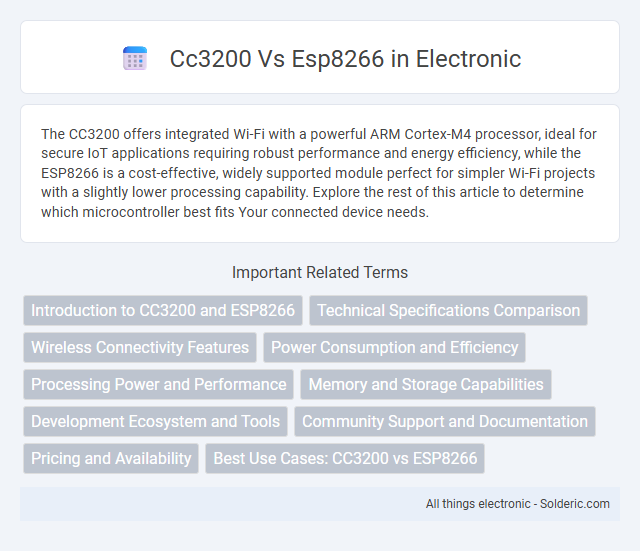The CC3200 offers integrated Wi-Fi with a powerful ARM Cortex-M4 processor, ideal for secure IoT applications requiring robust performance and energy efficiency, while the ESP8266 is a cost-effective, widely supported module perfect for simpler Wi-Fi projects with a slightly lower processing capability. Explore the rest of this article to determine which microcontroller best fits Your connected device needs.
Comparison Table
| Feature | CC3200 | ESP8266 |
|---|---|---|
| Manufacturer | Texas Instruments | Espressif Systems |
| MCU Core | ARM Cortex-M4 @ 80 MHz | Tensilica L106 32-bit @ 80 MHz |
| Wi-Fi Standard | 802.11 b/g/n | 802.11 b/g/n |
| RAM | 256 KB SRAM | 50 KB internal RAM + external PSRAM support |
| Flash Memory | Up to 1 MB internal flash | Typically 512 KB to 4 MB external flash |
| Power Consumption | Low power with multiple modes (Standby: ~6 uA) | Low power, but higher than CC3200 (Modem Sleep: ~15 mA) |
| Security | Hardware crypto accelerators, Secure Boot, TrustZone | WPA/WPA2 PSK, basic SSL support |
| Development Ecosystem | TI Code Composer Studio, Energia IDE | ESP-IDF, Arduino IDE, PlatformIO |
| GPIOs | Up to 31 GPIO pins | Up to 17 GPIO pins |
| Price | Higher (~$7-$10 per unit) | Lower (~$2-$5 per unit) |
Introduction to CC3200 and ESP8266
The CC3200 is a wireless microcontroller from Texas Instruments featuring a built-in ARM Cortex-M4 MCU and integrated Wi-Fi connectivity, optimized for IoT applications requiring low power and advanced security. The ESP8266, developed by Espressif Systems, is a cost-effective Wi-Fi module known for its simplicity and wide community support, leveraging a Tensilica L106 microcontroller. Understanding your project's needs helps determine whether the CC3200's robustness or the ESP8266's affordability is more suitable.
Technical Specifications Comparison
The CC3200 features a 80 MHz ARM Cortex-M4 MCU with 256KB SRAM and 1MB flash memory, while the ESP8266 uses a 80 MHz Tensilica L106 MCU with 160KB SRAM and up to 4MB flash. CC3200 supports Wi-Fi 802.11 b/g/n with integrated TCP/IP stack and hardware cryptographic accelerators, offering superior security and low power consumption. ESP8266 is favored for cost efficiency and community support, but CC3200 excels in processing power and robust wireless connectivity for IoT applications.
Wireless Connectivity Features
The CC3200 offers integrated Wi-Fi with built-in support for 802.11 b/g/n standards, providing robust security protocols including WPA2, WPA, and WEP, along with an embedded TCP/IP stack for seamless internet connectivity. In contrast, the ESP8266 supports 802.11 b/g/n Wi-Fi, featuring simple security settings and a highly flexible software development environment but requires more external components for full networking capabilities. Your choice depends on whether you prioritize a comprehensive hardware-software solution with advanced security (CC3200) or a cost-effective, widely supported Wi-Fi module (ESP8266).
Power Consumption and Efficiency
The CC3200 excels in power consumption with its ultra-low power modes designed for battery-operated IoT devices, offering deep sleep currents as low as 1.8 uA. In contrast, the ESP8266 features higher power consumption, typically drawing around 70-170 mA during active Wi-Fi transmission, which can impact overall efficiency in power-sensitive applications. For your projects requiring long battery life and efficient energy management, the CC3200 provides a more optimized solution.
Processing Power and Performance
The CC3200 features a 32-bit ARM Cortex-M4 processor running at 80 MHz, delivering robust performance for IoT applications with enhanced computational capabilities. In contrast, the ESP8266 utilizes a 32-bit Tensilica Xtensa LX106 core clocked up to 80 MHz, offering efficient Wi-Fi connectivity with moderate processing power. The CC3200 surpasses the ESP8266 in processing speed and integrated hardware accelerators, making it preferable for complex, real-time IoT tasks.
Memory and Storage Capabilities
The CC3200 offers 256KB of RAM and 1MB of internal flash storage, providing ample space for complex IoT applications and secure data management. In contrast, the ESP8266 features 80KB of RAM with external flash options typically ranging from 512KB to 4MB, requiring additional storage components for extensive data handling. Your choice between these chips should consider the CC3200's superior onboard memory and integrated security features versus the ESP8266's flexibility and external memory scalability.
Development Ecosystem and Tools
The CC3200 offers a robust development ecosystem with Texas Instruments' Code Composer Studio and Energia IDE, enabling seamless integration and advanced debugging capabilities for IoT applications. The ESP8266 boasts widespread community support and compatibility with the Arduino IDE, providing extensive libraries and examples that accelerate rapid prototyping and deployment. Both platforms benefit from strong SDKs, but the CC3200's TI-RTOS provides more real-time operating system features compared to the ESP8266's lightweight FreeRTOS integration.
Community Support and Documentation
The ESP8266 boasts a vast and active community with extensive forums, tutorials, and third-party libraries, making it easier for You to find solutions and resources for various projects. In contrast, the CC3200 benefits from strong Texas Instruments support and detailed official documentation, but its community is smaller and less diverse. Choosing between the two depends on whether You prioritize broad user-generated content or official technical guidance.
Pricing and Availability
The CC3200 typically comes at a higher price point compared to the ESP8266, reflecting its advanced features and integrated security capabilities. The ESP8266 is widely available and cost-effective, making it a popular choice for budget-sensitive IoT projects. Your choice depends on balancing budget constraints with the need for enhanced performance and security features.
Best Use Cases: CC3200 vs ESP8266
The CC3200 excels in IoT applications requiring robust security features, low power consumption, and integrated Wi-Fi with ARM Cortex-M4 processing, making it ideal for industrial automation and smart home devices. The ESP8266 offers a cost-effective solution with sufficient processing power and Wi-Fi capabilities suited for hobbyist projects, simple sensor networks, and basic home automation. Your choice depends on the need for advanced security and performance (CC3200) versus affordability and ease of use (ESP8266).
cc3200 vs esp8266 Infographic

 solderic.com
solderic.com